Flamingo

Flamingos or flamingoes are a type of wading bird in the family Phoenicopteridae, the only bird family in the order Phoenicopteriformes. Four flamingo species are distributed throughout the Americas, including the Caribbean, and two species are native to Africa, Asia, and Europe.
The name "flamingo" comes from Portuguese or Spanish flamengo, "flame-colored", The generic name phoenicopterus (from Greek: φοινικόπτερος phoinikopteros), literally "blood red-feathered" has a similar etymology.
Scientific Classification
| Kingdom: | Animalia |
| Phylum: | Chordata |
| Class: | Aves |
| Order: | Phoenicopteriformes |
| Family: | Phoenicopteridae Bonaparte, 1831 |
Species
the family was reclassified into two genera.
| Image | Species | Geographic location | |
|---|---|---|---|
 | Greater flamingo (Phoenicopterus roseus) | Old World | Parts of Africa, S. Europe and S. and SW Asia (most widespread flamingo). |
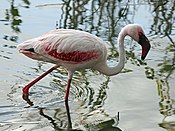 | Lesser flamingo (Phoenicoparrus minor) | Africa (e.g. Great Rift Valley) to NW India (most numerous flamingo). | |
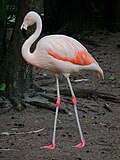 | Chilean flamingo (Phoenicopterus chilensis) | New World | Temperate S. South America. |
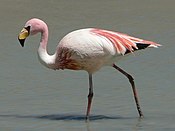 | James's flamingo (Phoenicoparrus jamesi) | High Andes in Peru, Chile, Bolivia and Argentina. | |
 | Andean flamingo (Phoenicoparrus andinus) | High Andes in Peru, Chile, Bolivia and Argentina. | |
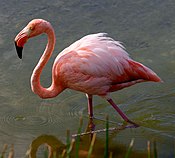 | American flamingo (Phoenicopterus ruber) | Caribbean islands, Caribbean Mexico, southern Florida,[17] Belize, coastal Colombia, northern Brazil, Venezuela and Galápagos Islands. | |
Description
Flamingos usually stand on one leg while the other is tucked beneath their bodies. The reason for this behaviour is not fully understood. One theory is that standing on one leg allows the birds to conserve more body heat, given that they spend a significant amount of time wading in cold water. However, the behaviour also takes place in warm water and is also observed in birds that do not typically stand in water. An alternative theory is that standing on one leg reduces the energy expenditure for producing muscular effort to stand and balance on one leg. A study on cadavers showed that the one-legged pose could be held without any muscle activity, while living flamingos demonstrate substantially less body sway in a one-legged posture. As well as standing in the water, flamingos may stamp their webbed feet in the mud to stir up food from the bottom.
Flamingos are capable flyers, and flamingos in captivity often require wing clipping to prevent escape. A pair of African flamingos which had not yet had their wings clipped escaped from the Wichita, Kansas zoo in 2005. One was spotted in Texas 14 years later. It had been seen previously by birders in Texas, Wisconsin and Louisiana.
Young flamingos hatch with grayish-red plumage, but adults range from light pink to bright red due to aqueous bacteria and beta-carotene obtained from their food supply. A well-fed, healthy flamingo is more vibrantly colored, thus a more desirable mate; a white or pale flamingo, however, is usually unhealthy or malnourished. Captive flamingos are a notable exception; they may turn a pale pink if they are not fed carotene at levels comparable to the wild.
The greater flamingo is the tallest of the six different species of flamingos, standing at 3.9 to 4.7 feet (1.2 to 1.4 m) with a weight up to 7.7 pounds (3.5 kg), and the shortest flamingo species (the lesser) has a height of 2.6 feet (0.8 m) and weighs 5.5 pounds (2.5 kg). Flamingos can have a wingspan as small as 37 inches (94 cm) to as big as 59 inches (150 cm)
https://drive.google.com/file/d/1YXQOmcQgu6Kj9r4Sqs7nZNskRXYxcTBa/view?usp=sharing
5 QUESTIONS:
1. why does the flamingo colour is pink?
2. what makes the flamingo extinct?
3. why does the flamingo usually stand on one leg?
4. does the flamingo be able to fly?
5. where usually flamingo stays?
https://drive.google.com/file/d/1YXQOmcQgu6Kj9r4Sqs7nZNskRXYxcTBa/view?usp=sharing
5 QUESTIONS:
1. why does the flamingo colour is pink?
2. what makes the flamingo extinct?
3. why does the flamingo usually stand on one leg?
4. does the flamingo be able to fly?
5. where usually flamingo stays?
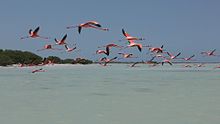

Komentar
Posting Komentar